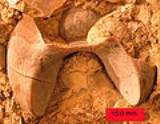
Hypostome
Encyclopedia
A hypostome is a calcified
harpoon-like structure near the mouth area of certain parasitic
arthropod
s including tick
s and mite
s (Order Acari), that allows them to anchor themselves firmly in place on a host
mammal while sucking blood
. This mechanism is normally so strong that removal of a lodged tick requires two actions: One to remove the tick, and one to remove the remaining head section of the tick.
 The apical
The apical
portion of the polyps of hydrozoa
n cnidaria
ns like Hydra
is referred to as a hypostome.
The term hypostome also refers to the ventral plate of trilobite
s and other arthropod
s (see Hypostome (tick)
).
Osseous tissue
Osseous tissue, or bone tissue, is the major structural and supportive connective tissue of the body. Osseous tissue forms the rigid part of the bone organs that make up the skeletal system.-Formation:Bone tissue is a mineralized connective tissue...
harpoon-like structure near the mouth area of certain parasitic
Parasitism
Parasitism is a type of symbiotic relationship between organisms of different species where one organism, the parasite, benefits at the expense of the other, the host. Traditionally parasite referred to organisms with lifestages that needed more than one host . These are now called macroparasites...
arthropod
Arthropod
An arthropod is an invertebrate animal having an exoskeleton , a segmented body, and jointed appendages. Arthropods are members of the phylum Arthropoda , and include the insects, arachnids, crustaceans, and others...
s including tick
Tick
Ticks are small arachnids in the order Ixodida, along with mites, constitute the subclass Acarina. Ticks are ectoparasites , living by hematophagy on the blood of mammals, birds, and sometimes reptiles and amphibians...
s and mite
Mite
Mites, along with ticks, are small arthropods belonging to the subclass Acari and the class Arachnida. The scientific discipline devoted to the study of ticks and mites is called acarology.-Diversity and systematics:...
s (Order Acari), that allows them to anchor themselves firmly in place on a host
Host (biology)
In biology, a host is an organism that harbors a parasite, or a mutual or commensal symbiont, typically providing nourishment and shelter. In botany, a host plant is one that supplies food resources and substrate for certain insects or other fauna...
mammal while sucking blood
Blood
Blood is a specialized bodily fluid in animals that delivers necessary substances such as nutrients and oxygen to the cells and transports metabolic waste products away from those same cells....
. This mechanism is normally so strong that removal of a lodged tick requires two actions: One to remove the tick, and one to remove the remaining head section of the tick.

Apical
Apical, from the Latin apex meaning to be at the apex or tip, may refer to:*Apical , an anatomical term of location for features associated with the base of an organism or structure...
portion of the polyps of hydrozoa
Hydrozoa
Hydrozoa are a taxonomic class of very small, predatory animals which can be solitary or colonial and which mostly live in saltwater. A few genera within this class live in freshwater...
n cnidaria
Cnidaria
Cnidaria is a phylum containing over 9,000 species of animals found exclusively in aquatic and mostly marine environments. Their distinguishing feature is cnidocytes, specialized cells that they use mainly for capturing prey. Their bodies consist of mesoglea, a non-living jelly-like substance,...
ns like Hydra
Hydra (genus)
Hydra is a genus of simple fresh-water animal possessing radial symmetry. Hydras are predatory animals belonging to the phylum Cnidaria and the class Hydrozoa. They can be found in most unpolluted fresh-water ponds, lakes, and streams in the temperate and tropical regions and can be found by...
is referred to as a hypostome.
The term hypostome also refers to the ventral plate of trilobite
Trilobite
Trilobites are a well-known fossil group of extinct marine arthropods that form the class Trilobita. The first appearance of trilobites in the fossil record defines the base of the Atdabanian stage of the Early Cambrian period , and they flourished throughout the lower Paleozoic era before...
s and other arthropod
Arthropod
An arthropod is an invertebrate animal having an exoskeleton , a segmented body, and jointed appendages. Arthropods are members of the phylum Arthropoda , and include the insects, arachnids, crustaceans, and others...
s (see Hypostome (tick)
Hypostome (tick)
A hypostome , is a calcified harpoon-like structure near the mouth area of certain parasitic arthropods including ticks, that allows them to anchor themselves firmly in place on a host mammal while sucking blood...
).

